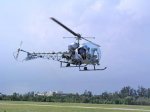I wonder if we should install some anti-crash airbag
Edward --
it is important to consider crashworthiness as a whole. Airbags protect only against some of the threats, not against others. Those threats include:
1. intrusion
a. of structure into the space of living occupants
b. of outside world (ground, tree, etc) into the space of living occupants
2. ejection of occupant
a. occupant unprotected by a/c structure
b. occupant suffers secondary impact against terrain etc.
3. Secondary impact
a. unrestrained or badly-restrained occupant impacts structure
4. deceleration forces
a. deceleration forces unsurvivable in absolute terms
b. deceleration forces unsurvivable due to design's not managing these forces.
c. deceleration forces along unexpected axis.
5. postcrash fire
a. fire not prevented or retarded
b. occupants can't escape due to design, damage to machine, or occupant injury
c. occupants not protected from fire.
As you can see, these multiple pathways of injury need multiple countermeasures. It is hard to do it all and still make a light and inexpensive machine.
You need at a minimum, to make a crashworthy machine:
1. to preserve the space for the humans inside and protect them from what's outside.
2. to restrain the humans so they don't get ejected.
3. to protect them from hitting things inside the machine, or suddenly hitting other parts of their own bodies, or snapping joints beyond what is survivable.
4. to manage deceleration forces (like the crumple zones in a car).
5. to keep fire from starting, especially in or near the crew compartment.
A solid rollover structure, good seat and shoulder straps, a helmet and possibly a HANS device, and some attention to fire management might do more than an airbag can. NASCAR and Formula 1 race drivers have no airbags but survive horrific impacts regularly.
Sorry for my long words, especially to those who are not native English speakers. But precision counts!
cheers
-=K=-




